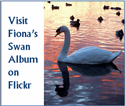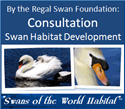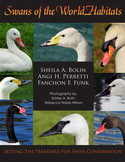Ask the Swan Specialist
Date: 29 January 2017
Hi Christine:
Unfortunately, the swans bred in the U.S. for sale to captive settings are not raised in swan houses and such, they really do not like to have any overhead structure such as a roof. We do know of a swan breeder in Illinois that uses floating nesting boxes (no roof) and you might contact him: Bob Knox, Knox Swans and Dogs: 847-875-3947.
He may have some swans that are used to such a platform.
Now, prior to procuring swans for your facility, there a several issues that must be addressed:
1. The Ohio DNR is killing Mute Swans like many other federal and state wildlife officials under the misrepresentation to the public that they are dangerous and detrimental to the habitat. The major reason they are killing Mute Swans is to introduce the larger Trumpeter Swans for Trophy Waterfowl hunting purposes. With this in mind, you need to procure a permit to have the swans.
2. You do not want breeding swans (male and female) because you would need a breeding license which would cause a whole other headache for your facility.
Therefore, you should request female Mute Swans. They have less hormone issues when the nesting/mating season occurs. Male swans become much more defensive due to testosterone level increase. Also, DO NOT allow the Ohio DNR or anyone else recommend Trumpeter Swans to be placed on your facility. These birds are much larger and therefore, much more difficult to handle. They weigh 40 lbs while the Mute Swans weigh between 26-30 lbs. So, a larger bird is going to require 2-3 people to hold and handle should a rescue for illness or injury be required.
3.You will need to build an introduction pen prior to getting your swans. The pen needs to be 12 x 24 feet. 12 feet wide, with 12 feet of the pen on land and 12 feet of the pen in the water with no steep bank, rocky or abrasive areas. Steep banks and abrasive substrates can cause injuries to the feet and legs.
A feeder should be placed in the pen (three feet from the bank on a pole to prevent pests such as rats and mice and predators such as raccoons from accessing the food once the pen is removed (if you choose to remove the pen at a later date. However, some individuals take the front off the pen facing the water and keep the pen as a veterinary pen should the need arise).
In any case, the feeder is placed in the water (feeder can be searched on this site to show what it looks like and how it works, but basically it is a dog feeder with a trap door and the swans can feed at will). The feeder is filled 1/2 way with a mixture of cracked corn and poultry layer pellet. Someone will need to enter the water on every other day to check on the amount of food that the swans are eating so they have ample food and to see if the food is damp or wet. Damp or wet food must be scooped into a bag and discarded away from other animals and birds. The wet food can develop a mold and sicken wildlife. The feeder must be kept completely dry and excessive rain may cause the feeder to be checked and dried and food to be scooped or completely emptied on a more frequent basis.
The swans are placed in the pen and are taught how to use the feeder, become familiar with their care takers, acclimate to you and the habitat itself. Approximately 2 weeks after introduction, they can be removed from the pen onto the pond so discover their new habitat. Just ensure that there is no area that they can enter that can cause injury such as thorn buses, steep banks, areas opening to open roadways etc. If they are in a pond completely surrounded by buildings, free from predators and escape, this is an ideal setting for the swans. They just need to have ample grassy areas for walking, preening and resting. On another note, they will still have fecal matter wherever they preen and rest on the ground. So, you may decrease a lot of the geese fecal matter, but the swans will still have some fecal material on the grassy areas.
4. You need to have someone (actually several people) who will be responsible for caring for the swans (able to carry 25-30 lbs if necessary, able to get in and out of the water, etc.) and check on the swans.
5. You will need to have 1-2 boats or kayaks to act as rescue/capture equipment should the swans get sick or injured. They will not come to you so you will need to get to them. If there is fishing on your lake, this increases the chance of injury to fishing line and tackle. Additionally, you may need to bring the swans indoors or into a small shed/barn during extremely inclement weather. If the lake freezes, they can drown, starve, be attacked by predators on the ice or develop stress and illness from not being able to feed and bathe normally. You cannot place any food on a frozen lake because predators will be drawn to the swans.
If the lake is small enough, you need to place a de-icer in the lake to keep it free from freezing. Even then, you must be able to provide some type of shelter for the swans during high winds and extreme cold.
Remember, your captive swans are pinioned (not able to fly)so you must provide for them as they can't just go somewhere else to avoid weather or predators.
We hope that this information is of benefit to you. The Regal Swan
Messages In This Thread
- how to build a swan house -- Christine -- 28 January 2017
- Re: how to build a swan house -- The Regal Swan -- 29 January 2017
Ask the Swan Specialist is powered by
Tetra-WebBBS 5.30 Beta © 2006-2007 Tetra-Team






